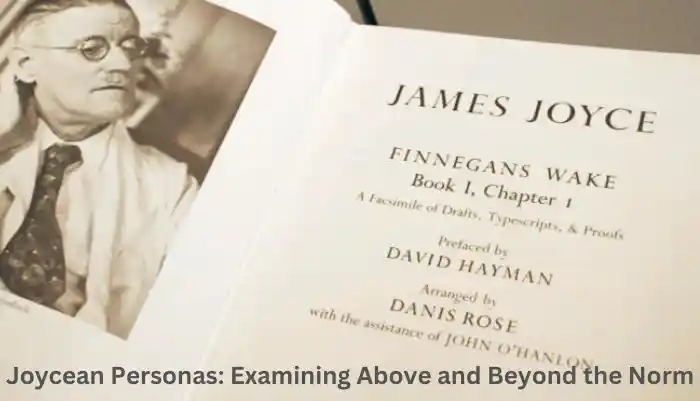Joycean Personas: Examining the Above and Beyond the Norm
Since Leopold Bloom is a crucial figure in James Joyce’s vast literary world, there is more to find in “Beyond Bloom.” Led by the spirit of “Joycean,” we explore the deepest desires and struggles of Joyce’s characters as we dive into Dublin’s depths. From everyday individuals to complex personalities, we analyze their roles in Dublin’s society, tracing the influence of myth and history on their lives. Join us as we uncover the rich complexity of Joycean characters, shedding light on their timeless quest for meaning.
Origin & Meaning of Joycean
The famous Irish writer James Joyce (1882–1941) is known for coining the term “Joycean,” which was first used likely between 1925 and 1930. Joyce is the last name he used to create it, and the suffix “-an,” which is often used to characterize something about a person or their work—much like “Shakespearean” or “Dickensian”—is put on it.
“Joycean” means two things in particular, such as
- The term covers all things related to James Joyce or his literary creations, such as life stories, popular novels like Ulysses and Dubliners, and his unique way of writing.
- It also highlights the unique qualities of Joyce’s writing style, indicating aspects like his creative use of language and storytelling, stream-of-consciousness narratives, and complex wordplay.
Unveiling the Joycean Psyche: Stream of Consciousness and Character Depth
In James Joyce’s writing, understanding characters goes beyond storytelling—it’s about diving deep into the human mind. We’re focusing on Joyce’s unique style, mainly how he uses “stream of consciousness.”
Joyce’s way of writing lets us see directly into the character’s thoughts and feelings, showing us their inner worlds with all their fleeting emotions and hidden desires. He also blends in the outside world seamlessly, making characters’ surroundings part of their inner reflection.
Nothing is as it seems, though. Joyce creates dynamic characters who are constantly changing as they struggle with their personas. This is similar to real life, where people continuously change and seek to figure out their identity.
In Joyce’s world, his style isn’t just a tool—it’s an invitation to explore the depths of human experience.
Unveiling Joycean Characters
While Leopold Bloom represents the commoner in James Joyce’s stories, focusing only on him limits our understanding of Joyce’s rich storytelling. Characters like Mr. Duffy in “Dubliners” and the unnamed protagonist in “Araby” offer different views on masculinity and adolescence, adding depth to the narrative.
Joyce’s female characters, such as Molly Bloom and Eveline, break traditional stereotypes, showing desires, struggles, and resilience within societal constraints. Even minor characters, like Gerty MacDowell in “Ulysses,” play important roles, reflecting internal battles and societal attitudes.
Looking beyond Bloom reveals Joyce’s full storytelling prowess, where characters of all importance levels provide diverse insights into life’s complexities. Exploring these nuances helps us appreciate Joyce’s world and the enduring impact of his stories.
The Joycean Landscape: Characters in Context

In James Joyce’s world, characters are deeply connected to Dublin’s backdrop, history, and language. Through “The Joycean Landscape,” we uncover the depths of characters like Mr. Duffy and Molly Bloom, exposing societal norms and broader themes. References to myth and history, such as Bloom’s journey echoing Odysseus’s, add layers of meaning. Language, including dialects and inner thoughts, shapes characters’ identities and provides valuable insights. Exploring this landscape reveals characters as products of their time, reflecting the universal truths of human existence.
Comprehending the Transformations of Joycean Figures
Characters in James Joyce’s novels experience significant “Moments of Epiphany,” giving light on fundamental aspects of their nature. These moments aren’t always grand but can come from everyday events, reshaping their understanding and prompting personal growth. Whether it’s Mr. Duffy rethinking love in “Dubliners” or Leopold Bloom finding shared humanity in “Ulysses,” these instances offer profound connections and realizations, going beyond storytelling tools to become pivotal moments in the characters’ development.
Read More: https://asseturi.com/compliancia-creating-an-ethical-culture-in-2024/
Myth and Reality: Mythological Motifs in the World of Joycean Characters
Mythological elements integrate into James Joyce’s characters, taking them above the ordinary and tying them to universal themes. One may liken Leopold Bloom’s voyage in “Ulysses” to Odysseus’s epic Odyssey, as each portrays combat with identity and a desire to connect. However, Joyce’s use of mythological motifs goes deeper, often challenging expectations. Take Molly Bloom’s inner monologue, contrasting with Penelope’s steadfastness in the Odyssey, adding complexity to her character.
Through these motifs, deeper layers of meaning emerge, like Stephen Dedalus’s identification with Daedalus, revealing his artistic ambitions. Similarly, the motif of Hamlet in “Ulysses” reflects timeless themes of family and betrayal, enriching characters such as Bloom and Dedalus. By weaving in mythology, Joyce transcends time, offering characters enduring struggles and desires, enhancing our understanding and appreciation of his literary legacy.
The Enduring Legacy of Joycean Characters
James Joyce’s characters go beyond the pages of his novels, leaving a lasting impact on literature and culture. This exploration dives into the ongoing significance of these characters, extending far beyond their initial creation. They’ve influenced writers across generations, inspiring them to explore new narrative forms and delve into profound aspects of the human experience.
Characters like Leopold Bloom and Stephen Dedalus have become emblematic of complex human nature and existential exploration. Their stories resonate with readers globally, solidifying their status as literary icons. Additionally, Joycean characters have made their mark in popular culture, appearing in adaptations and inspiring various artistic interpretations.
At their core, these characters reflect universal themes of identity, alienation, and the search for meaning, offering profound insights into the human condition. Through ongoing exploration and interpretation, they continue to enrich our understanding of literature’s transformative power.
Conclusion
So, after delving into the realms beyond Bloom and exploring the intricate layers of the Joycean psyche, we find ourselves at a turning point. These characters, infused with myth and firmly implanted in our memories, continue to beckon us. They serve as guides into a domain filled with symbols, psychological richness, and the diverse tapestry of human experience. Talking with the universe of Joycean characters is more than just an academic activity; it’s a continuous dialogue with our depth and the endless desire for narrative. Taking their invitation, we began off on an unending voyage of discovery, fascinated by the story’s continuing allure.
FAQs
- Isn’t Leopold Bloom the most crucial character in Joyce’s work?
Leopold Bloom has a big part in “Ulysses,” but James Joyce’s real strength is his cast. Unique perspectives from characters like Molly Bloom and Mr. Duffy from “Dubliners” help us to understand Joyce’s universe.
- What’s the deal with all the weird sentences in Joyce’s writing?
Joyce’s unusual sentences reflect a stream of consciousness, revealing the characters’ unfiltered thoughts and memories. Embracing this technique helps us delve into their complex inner worlds.
- Why does Joyce keep referencing myths? Do I need to know mythology to understand his characters?
Joyce’s references to myths add depth to character narratives, connecting them to timeless themes. While knowing myths can enhance appreciation, it’s okay to grasp the essence of the characters.
- Is Joyce’s writing too difficult for the average reader?
Joyce’s writing may be challenging, but resources like analyses and discussions can aid understanding. Unpacking layers of meaning reveals the richness of his characters and writing style.
- Why should I bother reading Joyce? What’s the point?
Studying Joyce’s characters is an improved journey. The timeless impact of narratives and the themes of identity and desire inspire readers to consider their own lives.
Click Here to read more about Asseturi.














Post Comment